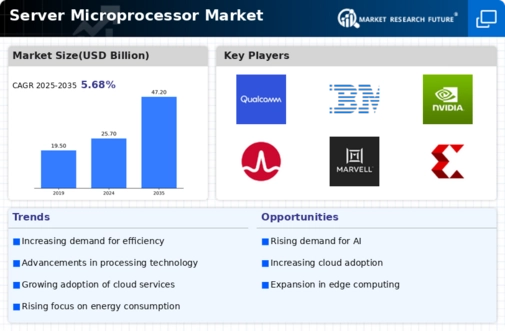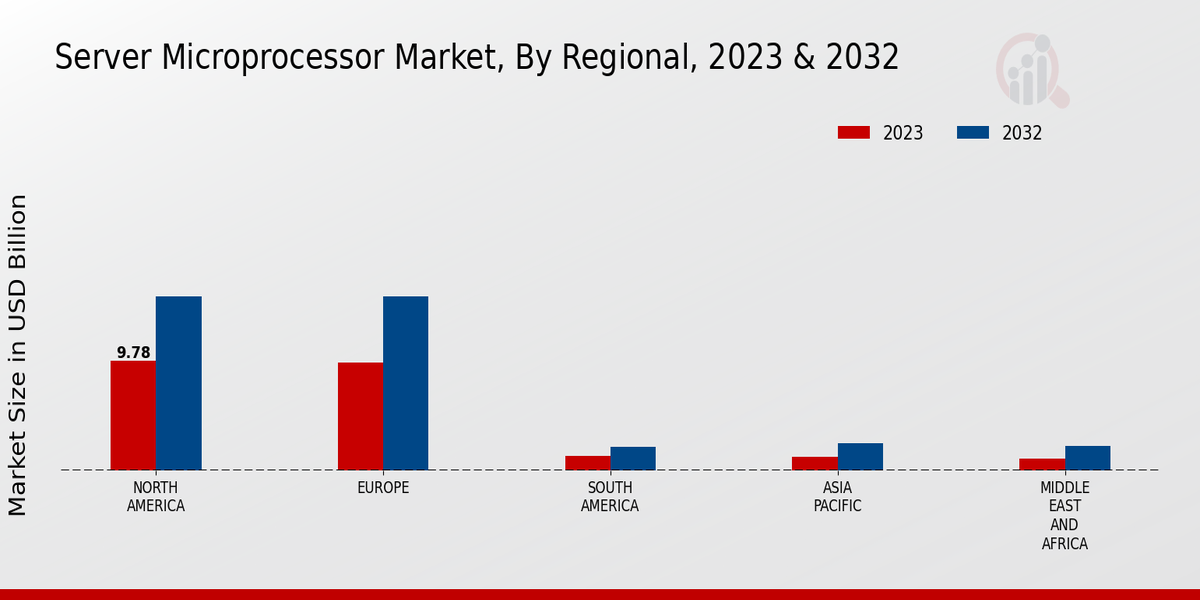Market Growth Projections
The Global Server Microprocessor Market Industry is poised for substantial growth, with projections indicating a rise from 25.7 USD Billion in 2024 to 47.2 USD Billion by 2035. This growth trajectory is supported by a compound annual growth rate (CAGR) of 5.68% from 2025 to 2035. The increasing demand for high-performance computing solutions across various sectors, including cloud computing, AI, and data centers, is likely to drive this expansion. As organizations continue to invest in advanced server technologies, the market is expected to witness significant developments, reflecting the evolving landscape of computing and the critical role of server microprocessors.
Growing Cybersecurity Concerns
The rising prevalence of cyber threats has heightened the focus on cybersecurity measures within the Global Server Microprocessor Market Industry. Organizations are increasingly investing in secure server infrastructures to protect sensitive data and maintain operational integrity. This demand for enhanced security features in server microprocessors is likely to drive innovation and development in the sector. As cybersecurity becomes a priority, the need for microprocessors that can support advanced security protocols and encryption methods will grow. This trend not only influences purchasing decisions but also shapes the overall landscape of the server microprocessor market, indicating a shift towards more secure computing environments.
Increased Data Center Investments
Investment in data centers is a crucial factor propelling the Global Server Microprocessor Market Industry. As organizations seek to enhance their IT infrastructure, the establishment of new data centers and the expansion of existing ones necessitate the deployment of advanced server microprocessors. These investments are driven by the need for improved data processing capabilities and storage solutions. The anticipated growth in the market, from 25.7 USD Billion in 2024 to 47.2 USD Billion by 2035, underscores the importance of data centers in shaping the demand for server microprocessors. This trend indicates a robust future for the industry as data centers evolve to accommodate increasing data traffic.
Rising Demand for Cloud Computing
The increasing adoption of cloud computing solutions is a primary driver of the Global Server Microprocessor Market Industry. As organizations migrate to cloud-based infrastructures, the need for powerful server microprocessors that can handle extensive workloads becomes critical. In 2024, the market is projected to reach 25.7 USD Billion, reflecting the growing reliance on cloud services. This trend is expected to continue, with the market potentially expanding to 47.2 USD Billion by 2035. The compound annual growth rate (CAGR) of 5.68% from 2025 to 2035 suggests that advancements in server microprocessor technology will play a pivotal role in supporting cloud operations.
Emergence of AI and Machine Learning
The proliferation of artificial intelligence and machine learning applications significantly influences the Global Server Microprocessor Market Industry. These technologies require high-performance computing capabilities, which are facilitated by advanced server microprocessors. As businesses increasingly integrate AI into their operations, the demand for microprocessors that can efficiently process large datasets is likely to surge. This shift not only enhances operational efficiency but also drives innovation in product development. The market's growth trajectory indicates that server microprocessors will be essential in meeting the computational demands of AI and machine learning, thereby contributing to the overall market expansion.
Technological Advancements in Microprocessor Design
Technological advancements in microprocessor design are pivotal in shaping the Global Server Microprocessor Market Industry. Innovations such as improved energy efficiency, increased processing power, and enhanced thermal management are driving the development of next-generation server microprocessors. These advancements enable organizations to optimize their server performance while reducing operational costs. As the market evolves, the introduction of cutting-edge technologies is expected to attract investments and foster competition among manufacturers. This dynamic environment suggests that the server microprocessor market will continue to grow, with new designs catering to the diverse needs of modern computing.



















Leave a Comment